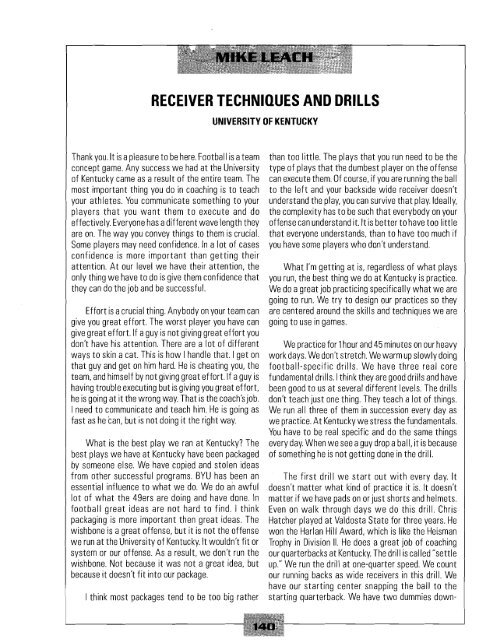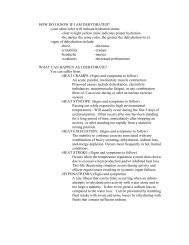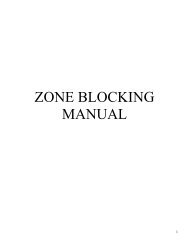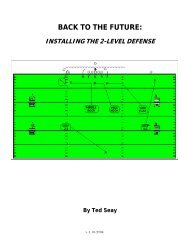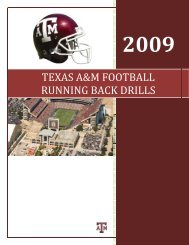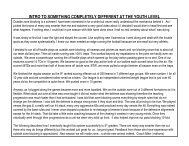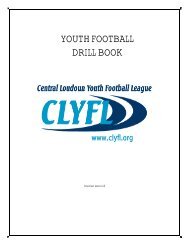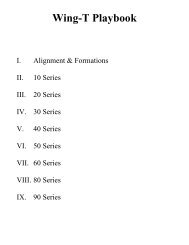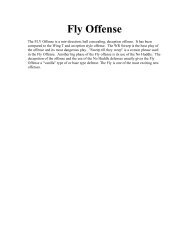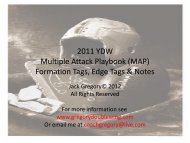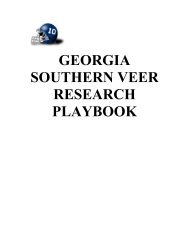Receiver Techniques and Drills - Mike Leach - Gregory Double Wing
Receiver Techniques and Drills - Mike Leach - Gregory Double Wing
Receiver Techniques and Drills - Mike Leach - Gregory Double Wing
Create successful ePaper yourself
Turn your PDF publications into a flip-book with our unique Google optimized e-Paper software.
RECEIVER TECHNIQUES AND DRILLSUNIVERSITY OF KENTUCKYThank you. It is a pleasure to be here. Football is a teamconcept game. Any success we had at the Universityof Kentucky came as a result of the entire team. Themost important thing you do in coaching is to teachyour athletes. You communicate something to yourplayers that you want them to execute <strong>and</strong> doeffectively. Everyone has a different wave length theyare on. The way you convey things to them is crucial.Some players may need confidence. In a lot of casesconfidence is more important than getting theirattention. At our level we have their attention, theonly thing we have to do is give them confidence thatthey can do .the job <strong>and</strong> be successf~.ll.Effort is a crucial tl-ling. Anybody on your team callgive you great effort. The worst player you have cangive great effort. If a guy is not giving great effort youdon't have his attention. There are a lot of differentways to ski11 a cat. This is how I h<strong>and</strong>le -that. I get onthat guy <strong>and</strong> get on him hard. He is cheating you, tlieteam, <strong>and</strong> himself by not giving great effort. If a guy ishaving trouble executing but is giving you great effort,he is going at it the wrong way. That is the coach's job.I need to communicate <strong>and</strong> teach him. He is going asfast as he can, but is ~ iot doing it -the right way.What is the best play we ran at Kentucky? Thebest plays we have at Kentucky have been packagedby someone else. We have copied <strong>and</strong> stolen ideasfrom other successful programs. BYU has been anessential influence to what we do. We do an awfullot of what the 49ers are doing <strong>and</strong> have done. Infootball great ideas are not hard to find. I thinkpackaging is more important then great ideas. Thewishbone is a great offense, but it is not the offensewe run at the Llniversity of Kentucky. It wouldn't fit orsysteni or our offense. As a result, we don't run thewishbone. Not because it was not a great idea, butbecause it doesn't fit into our package.I think most packages tend to be too big ratherthan too little. The plays that you run need to be thetype of plays that the dumbest player on the offensecan execute them. Of course, if you are running the ballto the left <strong>and</strong> your backside wide receiver doesn'tunderst<strong>and</strong> the play, you can survive that play. Ideally,the complexity has to be such that everybody on youroffense can underst<strong>and</strong> it. It is better to have too littlethat everyone underst<strong>and</strong>s, than to have too much ifyou have sollie players who don't underst<strong>and</strong>.What I'm getting at is, regardless of what playsyou run, the best thing we do at Kentucky is practice.We do a great job practicing specifically what we aregoing to run. We try to design our practices so theyare centered around the skills <strong>and</strong> techniques we aregoing to use in games.We practice for 1 hour <strong>and</strong> 45 minutes on our heavywork days. We don't stretch. We warm up slowly doingfootball-specific drills. We have three real corefu~idaniental drills. I think they are good drills <strong>and</strong> havebeen good to us at several different levels. Tlie drillsdon't teach just one thing. They teach a lot of things.We run all three of them in succession every day aswe practice. At Kentucky we stress the fundamentals.You have to be real specific <strong>and</strong> do the same thingsevery day. When we see a guy drop a ball, i.1: is becauseof something he is not getting done in the drill.The first drill we start out with every day. Itdoesn't matter what kind of practice it is. It doesn'tmatter if we have pads on or just shorts <strong>and</strong> helmets.Even on walk through days we do this drill. ChrisHatcher played at Valdosta State for three years. Hewon the Harlan Hill Award, which is like the HeismanTrophy in Division II. He does a great job of coachingour quarterbacks at Kentucky. The drill is called "settleup." We run the drill at one-quarter speed. We countour runl-ling backs as wide receivers in this drill. Wehave our starting center snapping the ball to thestarting quarterback. We have two dummies down-
-field which represent cover people. The receiversettles up between the two dummies, catches theball, <strong>and</strong> turns straight up field.The first fundamental thing that we emphasize isthe quarterback stance. We are looking for severalthings in the stance. We want pressure on the center'sbutt so the center has a target for the ball. Thequarterback's fingers are barely under the center. Weare a passing team <strong>and</strong> we want .the ball to come tothe h<strong>and</strong>s so we can get out from under the centerquickly. We want the quarterback high in his stance.His toes are turned in just slightly with the weight onthe balls of the feet. We want a slight bend in theknees <strong>and</strong> a relatively narrow stance, as compared tosome teams. We want the feet under I- is armpits. Thereason for that is to take a big first step. The back isrelatively straight <strong>and</strong> the eyes never leave downfield.As the quarterback takes his first step he wantsto cover as much ground as possible. He brings the ballto his ear. The ball is ready to be thrown at any point.When we do the three-step drop, we take a big firststep,cross over on the second, gather <strong>and</strong> throw onthe third step. On his third step, his back foot is slightlyto the outside. He can see the right side of the fieldbecause he is dropping to the right side. The back footbeing slightly outside allows his shoulders to beslightly open so he can see the back side also.We also back out from the center. We start withthe opposite foot. He steps back with his left foot,when he backs out from center. We do this drill withthe ball on a line. The quarterback drops down -thatline. You wouldbe surprised at the number ofquarterbacks who don't drop back straight.During this drill we are working on the centerexchange, the drop, <strong>and</strong> fine t1.1ning the throw. We callit "throwing darts." We want to get the thumb down<strong>and</strong> throw it where we want it.The receivers are being coached by the receivercoach during this period. The first thing we work on isthe receiver's stance. We tell the receivers to startlow <strong>and</strong> stay low. We want them to be relaxed, backsstraight, <strong>and</strong> still see downfield. As the receiver plantsto a run pattern, we want 90 percent of the weight onthe front foot. I want the h<strong>and</strong>s relaxed. I don't care ifthey carry them high. What I don't like is the statuelook. That .tightens the entire body. Any time you doanything athletic, you need to be relaxed. If thereceiver has trouble stabilizing, he needs to turr~ hisfront foot in slightly. The last thing we look for arefalse steps. We want them togo immediately forward.Don't let the receiver lift the front foot <strong>and</strong> take adouble step. He goes quarter-speed <strong>and</strong> works for theperfect move.As the receiver comes down the field <strong>and</strong> settles,he settles closer to one dummy than the other. Thedl~mmies are representing coverage like a linebacker.We want the receiver to form what we call a "noose"with the fingers. That means bring the fingers of theh<strong>and</strong>s together. We want the little fingers or thumbstogether. We emphasize catching the ball in the h<strong>and</strong>s,tucking it under the arm, <strong>and</strong> going straight upfield.We don't want the receiver's arm straight or benttoo far. If the arms are too s-traight, the ball can hitthe h<strong>and</strong>s <strong>and</strong> bounce forward. If that happens, -thereceiver has no chance of catching the ball. If the armsare too bent, the receiver can't see the ball if it jamshim. We want to catch the ball in our h<strong>and</strong>s. We wantto see the ball I-~it our h<strong>and</strong>s. The elbows are pinchedin to let the elbows hinge <strong>and</strong> soften the h<strong>and</strong>s. Evenif the guy tightens up his chest, if the elbows arepinched in, his elbow will hinge to a degree. Thatsoftens the h<strong>and</strong>s in spite of the fact he is doing a lotof -things wrong. There will be times during the courseof thegame where he catchesthe ball against his bodyor bats it around <strong>and</strong> catches it. But in practice we areworking for perfection.Once he catches the ball, he tucks it in. He tucksthe ball to the side that he receives it. He turns <strong>and</strong>goes straight upfield. We are not a big juke team. Thatgives you an advantage on a defender. The receiver hasmade an immediate decision on where he is going. Thedefender is wondering what the receiver is going todo with the ball. If the receiver turns <strong>and</strong> starts tojuke,lie has lost the advantage of the immediate decision.
Now everything is back to even, plus the pursuit iscoming. More often than not, turning straight upfieldwill enhance the yards after the catch. There is neverany gray area on that.As .the receiver -turns in between the dummies, -thequarterback throws the ball away from coverage. Inthis case he throws toward the 1 on the jersey. Hedoesn't throw toward the 9 in the number 19, becausethat is the side closest to the coverage. Thequarterback hits the 1, the receiver turns to that side,<strong>and</strong> goes straight up field. The quarterback call seethings the receiver sometimes can't. The receiver maythink he has coverage one way when actually theclosest coverage is the other side. Wherever thequarterback throws the ball, that is the side thereceiver wants to turn to. The quarterback puts theball in a catchable situation as far away froni thedefender as he can.The second drill we do is called "pat-n-go." In thisdr~ll we start out approximately half speed. We alignthe receivers in closer. They are barely outside -thehash marks. The receiver arc-releases. Then he givesup a little ground, gets his numbers toward the line ofscrimmage after he has taken about three steps,catches the ball <strong>and</strong> goes upfield. The quarterbacktakes a one-step drop <strong>and</strong> pats the ball. The receivercomes off slow like in a hot route situation. Thequarterback pats the ball <strong>and</strong> throws to the receiver.After that we get into our full-speed drills. Thisone is called "foot fire." This drill is designed to get arelease on a bump-<strong>and</strong>-run technique. The receiverworks his feet <strong>and</strong> h<strong>and</strong>s at a rapid rate. He is tryingto get the defensive back to react to the speed. Heworks his h<strong>and</strong>s <strong>and</strong> feet slightly inside, hoping thedefender will jump inside. That doesn't happen veryoften. If the receiver sees a lean in by the defender, hebursts outside. The receiver wants to give the illusionhe is going inside by speeding up .the feet <strong>and</strong> h<strong>and</strong>s.By alignment, our receivers are at the top of thenumbers. Inside the numbers belongs to the defender<strong>and</strong> outside the numbers belongs to the receiver. Wenever want to get pushed outside the numbers. Wewant to preserve as much ground as we can. If we getup against the sideline, there has to be a perfect throwto get the ball in there. If we preserve ground <strong>and</strong> holdat least the bottom of the numbers, the quarterbackhas a big area to throw the ball into. The receiverwants to lean in on the defender untll he sees the ballreleased. The ball is not a short ball. It is a ball withair under it. Now the receiver has a lot of room toadjust to the ball. The receivers are looking at thequarterback. Most of the time in this type of coveragethe defender is looking at .the receiver. The receivercan see the release <strong>and</strong> knows where the ball is goingto come down. The receiver gives the defender twosteps to the inside. The defender will loosen a bitbecause he thinks it might be a post. Physically if thereceiver is nice <strong>and</strong> low he can shove the defenderinside. He can't be blatant about it but he can movehim. If the ball is underthrown, the receiver call geardown <strong>and</strong> make the defender play through him to getto the ball. Of course, that is pass interference. Ideally,we don't want the ball thrown short or inside. We wantthe ball thrown over tlie receiver's outside shoulder.We take our quarterbacks <strong>and</strong> run the "barreldrill." We place barrels at certain places on the field<strong>and</strong> let the quarterbacks try to throw the ball intothem. The barrels are about 25 yards down the field.The quarterback takes his drop <strong>and</strong> tries to makebaskets in the barrels. The only way to do tha.t is putair under the ball. I'm not telling you we throw all theballs into the barrel. But if the ball is close, that is agood throw. The receivers can always adjust.This next drill is the best drill we run. We call it"routes on air." This drill teaches a lot of techniquesthat we do. This is particularly good to teach zonereads. We set up seven st<strong>and</strong>-up dummies. Theyrepresent the underneath five short zone players <strong>and</strong>the two deep hash defenders. You can set the dummiesup anywhere, to go against the defense you face. Wehave five quarterbacks line up in this drill. Last yearwe had between three <strong>and</strong> four, depending on whatthe JV team was doing. If we don't have all fivequarterbacks, our coaches would st<strong>and</strong> in for them. Allfive of the quarterbacks are lined up in the middle oftlie dr~ll taking an imaginary snap. The receivers are
lined up in a formation getting ready to run a play. Thereceivers work on their techniques of stance, routerunning, <strong>and</strong> good catching techl-~iques. The coachesare going to stress running great routes. Tlie receiverwants to settle in the biggest seam he can find. Wedo the drill from the 40-yard line going in. We want thereceiver to catch the ball, tuck it away, turn straightupfield, <strong>and</strong> score.When I did drill work like this I would imagine I wasworking against Lester Hayes. I ran a great route,turned around, <strong>and</strong> didn't get the ball. The ball wasthrown to someone else. That diminished my zeal torun a great route. In this drill, all five receivers get aball thrown to them. We want them to catch the ball.We can get through each drop back passing play thatwe run five times in a 15-minute period.The quarterbacks line up five in a row. They arekind of crowded, but that is the way I want it. Thequarterback lives in a crowded world a lot of the times.The quarterback has to get used to bodies beingaround him. We are working on the reads of thequarterback. We start out with the guy on the rightgoing through his reads. He throws the first read. Thenext quarterback .throws the second read. The guy onthe other end has the five read <strong>and</strong> throws his ball last.The reads are determined by the pattern being run. Thecoach can't really tell if the quarterback's eyes coveredthe five readslike he was supposed to, but he can tellthe first through fifth reads by the order in which theballs were delivered. If the balls are being released outof order, you know they are not going through theirreads. We rotate our quarterbacks, so they don't havethe same read each time. You find quarterbacks whowill get comfortable with a certain wide receiver. Wedon't want that. We want the quarterback to learn theentire play. It forces the quarterback to throw eachroute of each play in the course of this drill. He lhas toread the play in progression at least five times for eachplay that we run. For the number of reps, catches,throws, <strong>and</strong> the fact that the quarterback reads theplay in progression, this is the best drill we run.COALUYEpp-pppAfter we run our "routes on air," we do the samething versus "one-on-one." We take our number onedefensive backs <strong>and</strong> go against them. When we runour goal line offense or red-zone offense, we go to thegoal line to run them.The other thing I want to talk about are ourreleases. We see a lot of man coverage in the SEC. Welike to practice releases on a line. You can tell when areceiver has actually gotten over the top of adefensive back <strong>and</strong> back on the line. <strong>Receiver</strong>s are likedefensive linemen <strong>and</strong> corners are like offensivelinemen. That is kind of true. The corner is trying toprotect a cushion between the two of us. He is tryirlgto protect a space behind him. The receiver is tryingto break the cushion <strong>and</strong> get past the defensive back.The receiver is using rips <strong>and</strong> swims, which are usedby defensive linemen to get past offensive blockers.One of the most irr~portanthings that a receiverhas to do is attack half of the defensive back's body.The defensive backs are probably stronger <strong>and</strong> fasterthan the wide receivers. Therefore, I only attack halfof his body. If I'm trying toget outside, I only attacktheouts~de ~nurnber of the defensive back.The first thing the receiver is going to do is "footfire." The defensive back is all wound up. He is goingto wreck the receiver's route. I want to loosen thedefensive back up <strong>and</strong> at the very minimum get hisweight distributed on his inside foot. The "foot fire"creates i~idecisio~i on the defenders part. If thedefender lunges at the receiver, the receiver should goby him immediately. The only way a lunge works is ifthe defenders get all of the receiver <strong>and</strong> put him on
his back. Alabama did that to our receivers. Theylunged at us. Defensive players are wound tighter thanoffensive football players, particularly the defensivebacks. In the back of the defensive back's mind is, "If Ifoul this thing up, it is six points."The first thing defensive backs want is toget theirh<strong>and</strong>s on the receiver. The receiver never wants thedefensive back's h<strong>and</strong>s on him. As long as he can haveseparation he has time to react to what the receiveris going to do. The receiver doesn't want him to haveany time to react. Whether it is in the course of a routeor the release, always knock the defender's h<strong>and</strong>s off.What we try to do is break the elbow with a rip. Thatalso causes the defender's shoulder to turn, whichallows us to get by <strong>and</strong> into a move. When we aredoing the rip move, as the h<strong>and</strong> comes through, the footmust come through also. When the receiver's foot getsthrough, he is open. If the receiver gets over the top ofthe defender, he has a two-way go. If the receiver hassuperior position, it doesn't matter if the defender isfaster, the receiver is going to win.At times the defender will be really strong. He isnot just a little stronger than the receiver, he issufficiently stronger. We do the same thing. We usethe foot fire. But when we go to knock his h<strong>and</strong>s off,we have togo to the ends of his wrists. But if you haveto go to the ends of the wrist, instead of .the elbow,we can't turn the shoulders as well. Always comedown on a defender's h<strong>and</strong>s, not up. If you come downon the arms, it won't hurt you much, but it will hurt thedefender. I like the rip because it keeps the receiverlow. I don't like the swim move, unless the receiver istall. It exposes too much body. The swim I like to do iscalled the "short swim." Instead of coming over theshoulder, the receiver swims over the arms.I like big receivers over small receivers. A smallreceiver has to be great with his feet <strong>and</strong> great atgetting skinny. He is a little target for .the defender towork on. There is very little surface to hold him up. Theadvantage of a big receiver is his arms are generallylonger than the defensive back. If the receiver is big,he can do anything he wants with the defensive back.He can't get his h<strong>and</strong>s on me like I can him. I can turnhis shoulder just for the simple reason I have longerarms. A tall receiver is a bigger target <strong>and</strong> is hard tohold on the line of scrimmage. He has more leveragebecause of those arms. However, each receiver has touse what he does best.Let's talk a little about rur~~ii~ig routes. There arevarious things that are going to happen before thereceiver gets to the point he is going to break his route.The route may break at 10 or 15 yards, but it doesn'tmatter. Yo11 know where the route breaks <strong>and</strong> thedefender doesn't. That is the receiver's ace in -the hole.As the receiver goes upfield he needs to be on the sideof the defender that the route is going to break to. If Iam on the other side of the defender, I have to crosshis whole body. If the body position is right, thereceiver can lean on the defender, break the route, <strong>and</strong>at the rnir~iniurn be open for al-I instant.If the receiver beats the defender at the line <strong>and</strong>gets behind him, he should move in the direction wherehe last saw the defender. The defender has panicked<strong>and</strong> is going to go to the last place he saw him. If thereceiver does that first lie will be a step ahead of thedefender.When a receiver runs a route, I think it is veryimportant to have his numbers on his jersey over hisfeet. I mean when the receiver sticks or breaks a route.The best way to figure out if your players have theirnumbers over their feet is to have a wet day outside. Iwatched a lot of film <strong>and</strong> found the same guy slippingdown all the time. Come to find out his weight wasn'tover his feet. I don't believe slipping is entirely anaccident. If you slow the projector down <strong>and</strong> watch aguy's slip, liis ~iurr~bers are back <strong>and</strong> I-~is feet forward.There is no weight over his feet <strong>and</strong> he slips. If thereceiver can stay relatively low, at some point in hisroute he will have an encounter with the defender. Ifthe receiver can stay low, that helps to keep theweight over the feet. When the numbers on thereceiver's jersey come up <strong>and</strong> go back, the defensiveback reads that as a break. He closes on the receiver<strong>and</strong> pins his hip. We never show our numbers to thedefensive back.
his back. Alabama did that to our receivers. Theylunged at us. Defensive players are wound tighter thanoffensive football players, particularly the defensivebacks. In tlie back of tlie defensive back's mind is, "If Ifoul this thing up, it is six points."The first thing defensive backs want is to get theirh<strong>and</strong>s on the receiver. The receiver never wants thedefensive back's h<strong>and</strong>s on him. As long as he can haveseparation he has time to react to what the receiveris goiqg to do. 'The receiver doesn't want him to haveany time to react. Whether it is in the course of a routeor the release, always knock thedefender's h<strong>and</strong>s off.What we try to do is break the elbow with a rip. 'Thatalso causes the defender's shoulder to turn, whichallows us to get by <strong>and</strong> into a move. When we aredoing the rip move, as the h<strong>and</strong> comes tl-rough, tlie footmust come through also. When the receiver's foot getsthrough, he is open. If the receiver gets over the top ofthe defender, he has a two-way go. If the receiver hassuperior position, it doesn't matter if the defender isfaster, the receiver is going to win.At times the defender will be really strong. He isnot just a little stronger than the receiver, he issufficiently stronger. We do the same thing. We usethe foot fire. But when we go to knock his h<strong>and</strong>s off,we have to go to the elids of his wrists. But if you haveto go to the ends of the wrist, instead of the elbow,we can't turn the shoulders as well. Always comedown on a defender's h<strong>and</strong>s, not up. If you come downon the arms, it won't hurt you much, but it will hurt thedefender. I like the rip because it keeps the receiverlow. I don't like the swim move, unless the receiver istall. It exposes too much body. The swim I like to do iscalled the "short swim." Instead of coming over theshoulder, the receiver swims over the arms.I like big receivers over small receivers. A smallreceiver has to be great with liis feet <strong>and</strong> great atgetting skinny. He is a little target for the defender towork on. There is very little surface to hold him up. Theadvantage of a big receiver is his arms are generallylonger than the defensive back. If the receiver is big,lie can do anything he wants with the defensive back.He can't get his h<strong>and</strong>s on me like I can him. I call turnhis shoulder just for the simple reason I have longerarms. A tall receiver is a bigger target <strong>and</strong> is hard tohold on the line of scrimmage. He has more leveragebecause of those arms. However, each receiver has touse what lie does best.Let's talk a little about running routes. There arevarious things that are going to happen before thereceiver gets to the point he isgoing to break his route.The route may break at 10 or 15 yards, but it doesn'tmatter. You know where the route breaks <strong>and</strong> thedefender doesn't. That is the receiver's ace in tlie hole.As the receiver goes upfield he needs to be on the sideof the defender that the route is going to break to. If Iam on the other side of the defender, I have to crosshis whole body. If the body position is right, thereceiver can lean on tlie defender, break .the route, <strong>and</strong>at the minimum be open for an instant.If the receiver beats the defender at the line <strong>and</strong>gets behind him, he should move in the direction wherehe last saw -the defender. The defender has panicked<strong>and</strong> is going to go to tlie last place he saw him. If thereceiver does that first he will be a step ahead of thedefender.When a receiver runs a route, I think it is veryimportant to have his numbers on his jersey over hisfeet. I mean when the receiver sl:icks or breaks a route.The best way to figure out if your players liave theirnumbers over their feet is to have a wet day outside. Iwatched a lot of film <strong>and</strong> found the same guy slippingdown all the time. Come to find out his weight wasn'tover his feet. I don't believe slipping is entirely anaccident. If you slow the projector down <strong>and</strong> watch aguy's slip, his numbers are back <strong>and</strong> his feet forward.There is no weight over his feet <strong>and</strong> he slips. If thereceiver can stay relatively low, at some point in hisroute he will have an encounter with the defender. Ifthe receiver can stay low, that helps to keep theweight over the feet. When tlie numbers on thereceiver's jersey come up <strong>and</strong> go back, the defensiveback reads that as a break. He closes on the receiver<strong>and</strong> pins his hip. We never show our numbers to thedefensive back.
When the receiver gets ready to make his breakwe want him to accelerate the h<strong>and</strong>s. That give's thedefensive back the impression that the receiver isgoing faster then he is, instead of gearing down.I'm big on "stick routes." Occasionally, by alignmentwe are outside the defender. The receiver has .thedefensive back beat on the out by alignment. Thereceiver wants to get to the out as quick as he can. Ifhe does that the speed can't get there to cover. If thereceiver sticks a route it allows him to cut reallysharply. I think it distributes the weight of the receiver<strong>and</strong> allows him to come out of his cut really fast. If areceiver sticks his route, it makes the defensive backhesitate.Defensive backs are kind of paranoid people. Theydon't like to have their space invaded. There will be atime in a receiver's route where the defensive backtries to get his h<strong>and</strong>s on the receiver. It will happenwhen the receiver breaks his cushion. The receiver hasto get the defensive back's h<strong>and</strong> off him. Knocking theh<strong>and</strong>s down has to be a constant thing. 'The reason isdefensive backs kind of see with their h<strong>and</strong>s. He can'tsee the receiver, but if his h<strong>and</strong>s are or1 him, he knowswhere he is. If you knock his h<strong>and</strong>s off, he gets anuncomfortable feeling.Another thing that is kind of in the experimentalstages is how to break the route once the receiverbeats the defensive back. The receiver goes ver-tical<strong>and</strong> brakes the defensive back's cusl-lion. He has to turnto run with .the receiver. If the receiver wants to breakhis route to the outside, he leans on him <strong>and</strong> breaks.The lean tells the defensive back the receiver is goingoutside. There will be a time in the route where .thedefensive back will have his back to the receiver. It islike the trick you played on your buddies in school. Youreach around <strong>and</strong> pat him on the shoulder away fromyou. He looks that way. Instead of leaning into thedefensive back <strong>and</strong> breaking that way, touch him onthe other side. When the defensive back is nottouching the receiver <strong>and</strong> his back is turned is the mostvulnerable position. If the receiver touches thedefensive back on -the off shoulder <strong>and</strong> breaks theother way, you w ~ll be surprised what will happen.Most of the time the defensive back takes a couple ofsteps to the side that you touch.We stress coming back for the ball <strong>and</strong> catching itat the highest point. You are losing ground on the routebut you are gaining ground on the defender. Thereceiver is creating more separation between himself<strong>and</strong> the defender.We have a couple of receivers right now who runwith their arms outstretched. They see the ball in theair <strong>and</strong> they run for 15 yards wi-th their arms stretchedout. All that is doing is telling the defender that theball is conling <strong>and</strong> probably is in the vicinity of thereceiver's h<strong>and</strong>s. When they do that it breaks thereceiver's stride. He is not low any more in a full-outsprint. He is like a pizza delivery guy. We work oncatching .the ball without making a sound. That meansdevelop soft h<strong>and</strong>s.We do two drills at post-practice. We split thereceiver in half <strong>and</strong> work with the jugs machine. Wework on h<strong>and</strong> placement, <strong>and</strong> reac1:ion catching. Thedrill I like is called the "last fivesteps of a route." Thatdrill IS exactly what it says. The quarterback takes hisdrop. The receiver is down the field about 10 yards.About half way through the quarterback's drop, thereceiver sticks his route, looks back to thequarterback, <strong>and</strong> catches the post. All he has run is 5steps <strong>and</strong> he has gotten a catching rep. He can run 40posts without expending any serious energy.I appreciate the opportunity to talk to you. If wecan ever do anything for ~UIJ at the University ofKentl~cky give us a call. Thank you.


